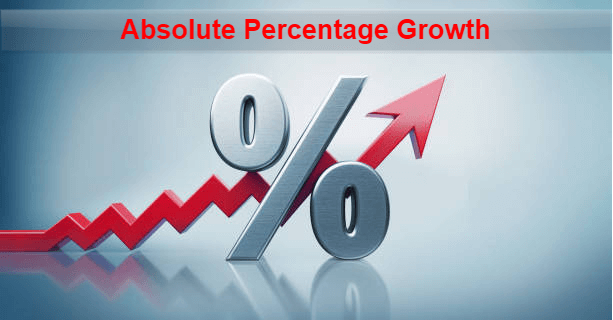Absolute Percentage GrowthAbsolute percentage growth is a rise in an asset's or account's value represented as a percentage. Absolute percentage growth signifies that the rise in value is shown on a stand-alone basis rather than in comparison to another asset or a benchmark. 
The profits or losses are thus measured using absolute percentage growth, often known as the absolute return, independent of any benchmark or other criterion. Performance in the investment sector is often assessed relative to other investments rather than in absolute terms. For instance, a small-cap U.S. mutual fund may have increased 30% over the course of a year, which is a solid return by any measure. But if the Russell 2000 index, a small-cap index it follows, is up 35%, the fund is thought to have underperformed its benchmark by five percentage points. It would also be compared to other funds in its category to determine if the fund has excelled or underperformed its peers. The phrase "absolute percentage growth" might be a little misleading because "absolute" can occasionally refer to the total gain or loss in asset worth in dollar terms, while "percentage" refers to the relative change (increase or decrease) over time. As a result, if the price of stock X rises from $10 to $15, the absolute gain is $5, and the percentage increase is 50%. Therefore, absolute growth (or absolute return) in percentage terms could be a better name for the concept. Special ConsiderationsRetail investors often care more about absolute returns, whereas institutional investors concentrate on relative returns. When setting investing goals, a retail investor may tell the adviser that the target return for a portfolio should be, for instance, 5% or 7%; nevertheless, the typical investor is frequently unlikely to insist that the portfolio outperforms a specified benchmark by x percentage points over time. In brutal bear markets, the retail investor's performance focus on absolute growth rather than the relative growth in a portfolio can be problematic, particularly if the individual is very risk-averse. The fact that such an investor's stock portfolio has beaten the benchmark by 10% yet is still down 10% in a year where the benchmark index is down 20% is probably of little comfort to the investor. Example of Relative Return vs. Absolute ReturnAbsolute return versus relative return can be seen in instances of various market cycles, such as bull versus bear, as well as in many others. In a bull market, about 2% would be considered a dismal return. However, merely maintaining the capital would be considered a success in a bear market since many investors may be down as much as 20% in this market. A 2% return seems okay in that situation. Depending on the context, the return's value varies. The absolute return, in this case, would be 2%. A 2% return is terrible in a bull market and favorable in a bear market due to relative return. The return's relative value is more important in this situation than the return's actual dollar value.
Next TopicAccelerated Depreciation
|
 For Videos Join Our Youtube Channel: Join Now
For Videos Join Our Youtube Channel: Join Now
Feedback
- Send your Feedback to [email protected]
Help Others, Please Share









